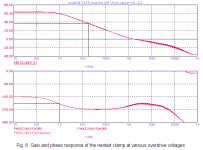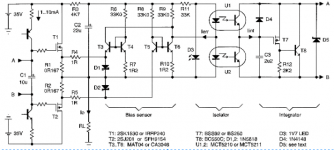😀My standard answer when somebody is questioning my practical measurements experience.
Then could you please take a picture about the FCD in a real life amp..? 🙂
Cortez, perhaps people do that all the time in Hungary, but around Toronto area or here in Bogor unfortunately, a real amp can only take real signal as input, he can not feed a real amp with a hypothetical signal so he could take picture nor measure the associated virtual FCD distortion. Since you are in Hungary, you have the best chance to do it for us. Please obtain appropriate gears to take the picture for us so we could be enlightened about what kind of alien beast this FCD really is. 

sin08, the workplace looks beautiful, but it doesn't tell me anything at all. I am interested in your specific business: your amplifier designs, scientific articles, etc.
sin08, the workplace looks beautiful, but it doesn't tell me anything at all. I am interested in your specific business: your amplifier designs, scientific articles, etc.
So you think syn08 has all that equipments to take a selfie in front of it?😱
indra1, I looked at your link, but I am not interested in circuits with the first pole of 1 kHzPetrov, read my #956 post and click the links.
Attachments
indra1, I looked at your link, but I am not interested in circuits with the first pole of 1 kHz
You do not know anything about compensation. Your schematic is previous thread was unstable.
You should only read the measurement, which is THD 0,0001% in all audio frequency.
12 years ago I tried to implement this circuit in a serial amplifier. It was very tempting to exclude the operation of adjusting the quiescent current of the output stage.
Everything worked flawlessly. However, as soon as I got to the test for clipping at a frequency of 20 kHz within a few minutes, the circuit immediately refused to work. This test was required. If the amplifier could not stand it, the development did not go into production.
bimo, I gave the scheme with ten zeros after the decimal point and showed that it will work "dead"
Everything worked flawlessly. However, as soon as I got to the test for clipping at a frequency of 20 kHz within a few minutes, the circuit immediately refused to work. This test was required. If the amplifier could not stand it, the development did not go into production.
bimo, I gave the scheme with ten zeros after the decimal point and showed that it will work "dead"
Attachments
Last edited:
sin08, the workplace looks beautiful, but it doesn't tell me anything at all. I am interested in your specific business: your amplifier designs, scientific articles, etc.
The link I gave you is the amplifier designed by Syn08 whatever the first pole may be. It seems you are having problem understanding english.indra1, I looked at your link, but I am not interested in circuits with the first pole of 1 kHz
syn08, kindly and tell me, have you made at least one amplifier in your life? If so, which one? What measurements did you take? What devices did you use?
If it's not difficult, share your work as Graham did, describing in detail the amplifier settings and the measurement results, and thereby leaving behind a good memory for those who understand this
There was an article about his amplifier on tubecad Upside-Down Differential Amplifier
Well, if you do not understand anything about development, but only a theoretician who is divorced from reality, then which of us is a troll?
Time to apologize for your perky insults.😡
He does not seem to understand, needs somebody to tell him in Russian or something. He was told his amp is not stable and reply with a story about his failure 12 years ago. Or maybe we should just keep our silence and let him waste his own time and money building unstable amplifiers if he is determined to fail that much.
Last edited:
This thread becomes more and more entertaining and “fascinating” by every passing day. It remains me on some of Joe Rasmussen’s threads where same “logic” was used to adjust physics laws to the personal liking.
Petr_2009 didn’t answer straight on any question, posting some random pictures and sentences which relation to the asked question is lost on anybody else.
Seems that one has to have certain level of scientific achievements and acclaimed designs before his words would be even considered by petr_2009. It’s a pity that he fails to introduce his achievements to us, as they are surely fascinating.
Petr_2009 didn’t answer straight on any question, posting some random pictures and sentences which relation to the asked question is lost on anybody else.
Seems that one has to have certain level of scientific achievements and acclaimed designs before his words would be even considered by petr_2009. It’s a pity that he fails to introduce his achievements to us, as they are surely fascinating.
It's all part of the USP. Have you tried having a conversation with planet 10 about physics laws etc? That can be equally entertaining and often pointlessIt remains me on some of Joe Rasmussen’s threads where same “logic” was used to adjust physics laws to the personal liking.
It turned out clearly. What personal conclusions were you able to draw from this simulation? In addition, look at the amplitude characteristic to understand where the frequency of 10 kHz is located on it, which you supplied - this is also an important point.1st: that's the result if the delay is 840ns.Input filter: 1k + 330pF.
2nd: that's the error with 430ns with 1k + 1nF filter.
3rd: just the error of the 430ns case.
And of course there's also a similar error at the end if the signal stops quickly.

P.S. I posted the wrong graphs earlier because I forgot to install a 220pF capacitor around the op amp. So do not pay attention to them, everything turned out to be not so pronounced because of this.
sin08, the workplace looks beautiful, but it doesn't tell me anything at all. I am interested in your specific business: your amplifier designs, scientific articles, etc.
There is one particular area where he does not seem to be highly accomplished, which is careful skilled listening. They don't teach it in college, so it can't be worth much (I guess that is the thinking, something like that anyway). Besides, many engineers scoff at the very idea. They don't believe in it.
Ahem, …. have you managed to observe that alleged “first cycle distortion” by careful listening? 😀
Personal friction between you and syn08 is carried on in every thread where other one posts something. Play nice and fair please.
Personal friction between you and syn08 is carried on in every thread where other one posts something. Play nice and fair please.
You guys still going at it? C'mon gents, either call it quits and agree to disagree or lets see some proof, petr_2009 seems to be convinced he's right, and this can be heard, then his mission is to provide evidence, otherwise this is all as valid as crygenic cooling of OFC cables in order to realign the atoms and reduce cable resistance further.
Ahem, …. have you managed to observe that alleged “first cycle distortion” by careful listening?
No. However, I do know professional amplifier designers that test with square waves and challenging loads. They want to be sure the amp is bulletproof enough so there won't be problems out in the field, and that the amp will sound as it should even in difficult conditions.
- Home
- Amplifiers
- Solid State
- First cycle distortion - Graham, what is that?

